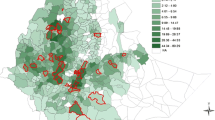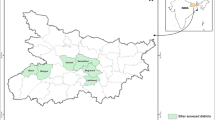Abstract
Increasing agricultural productivity through the dissemination of improved cropping practices remains one of the biggest challenges of this century. A considerable amount of literature is dedicated to the adoption of improved cropping practices among smallholder farmers in developing countries. While most studies focus on cash crops or main staple crops, traditional food grains like finger millet have received little attention in the past decades. Traditional food grains have however an important potential to improve food security, reduce micronutrient deficiencies, and enhance smallholder adaptation to climate change. The present study aims to assess the factors that influence adoption decisions among finger millet farmers in western Kenya. Based on cross-sectional household data from 270 farmers, we estimated a multivariate probit model to compare the adoption decisions in finger millet and maize production. While improved practices such as the use of a modern variety or chemical fertilizer are relatively well adopted in maize production, they are less common in finger millet production. Social networks as well as access to extension services play crucial roles in the adoption of improved finger millet practices, while the same variables are of minor importance for the adoption of improved maize practices. A Cobb-Douglas production function shows a positive effect of modern varieties and chemical fertilizer on finger millet yields.
Similar content being viewed by others
Notes
FAOstat does not differentiate between different types of millet.
The administrative areas in Kenya were regularly subject to reforms that split districts into smaller units. Given the availability of data to construct a sampling frame, we refer to the number of districts and district boundaries that existed before the 2007 reform. The latest reform in 2013 classified 47 counties (based on 46 districts as defined in 1992 and Nairobi) that we refer to in brackets for greater clarity.
This variable includes all income generated from skilled and unskilled self-employment as well as skilled and unskilled wage labor.
Regarding extension, we included a dummy that equals one if the household received maize (not millet) related extension. Furthermore, we included a variable on the gender of the person responsible for maize (not millet) production.
Alternatively, a translog production function would increase the flexibility of the model. However, in our data set the translog functional form leads to problems of multicollinearity. We therefore chose the more restrictive Cobb-Douglas functional form.
This includes both hired and family labor.
It is important to keep in mind that farmers who have received finger millet related extension were oversampled in our data and that the simple descriptive adoption rates presented here are therefore not representative for the whole region in the case of finger millet.
We calculated the marginal effects by introducing an observation where all variables equalled the mean value of that variable. The marginal effect of a dummy variable was measured as the change in the predicted probability of that observation due to a change of the dummy value from zero to one. The marginal effect of a continuous variable was measured as the change in the predicted probability due to an increase of the mean value by 1. In the case of off-farm income, the mean value was increased by 1 % to measure the marginal effect.
Since the dependent variable is log-dependent, coefficients of dummy variables are interpreted as [exp(coefficient)-1]*100
References
Afari-Sefa, V., Rajendran, S., Karanja, K. D., Musebe, R., Samali, S., Makaranga, M. A., & Kessy, R. F. (2015). Impact of nutritional awareness of traditional African vegetables on farm household production decisions: a case study of smallholders in Tanzania. Experimental Agriculture. doi:10.1017/S0014479715000101.
Battese, G. E. (1997). A note on the estimation of Cobb‐Douglas production functions when some explanatory variables have zero values. Journal of Agricultural Economics, 48(1–3), 250–252.
Besley, T., & Case, A. (1993). Modeling technology adoption in developing countries. The American Economic Review, 83(2), 396–402.
Byerlee, D., & Eicher, C. K. (1997). Africa’s emerging maize revolution. Boulder: Lynne Rienner Publishers.
Cavatassi, R., Lipper, L., & Narloch, U. (2011). Modern variety adoption and risk management in drought prone areas: insights from the sorghum farmers of eastern Ethiopia. Agricultural Economics, 42(3), 279–292.
Conelly, W. T., & Chaiken, M. S. (2000). Intensive farming, agro-diversity, and food security under conditions of extreme population pressure in western Kenya. Human Ecology, 28(1), 19–51.
Conley, T. G., & Udry, C. R. (2010). Learning about a new technology: pineapple in Ghana. The American Economic Review, 35–69.
Croppenstedt, A., Demeke, M., & Meschi, M. M. (2003). Technology adoption in the presence of constraints: the case of fertilizer demand in Ethiopia. Review of Development Economics, 7(1), 58–70.
Crowley, E., & Carter, S. (2000). Agrarian change and the changing relationships between toil and soil in Maragoli, Western Kenya (1900–1994). Human Ecology, 28(3), 383–414.
de Groote, H., Owuor, G., Doss, C., Ouma, J., Muhammad, L., & Danda, K. (2005). The maize green revolution in Kenya revisited. Journal of Agricultural and Development Economics, 2(1), 32–49.
Doss, C. R., & Morris, M. L. (2000). How does gender affect the adoption of agricultural innovations? Agricultural Economics, 25(1), 27–39.
FAO. (2012a). CountrySTAT Kenya—Indicators. Resource document. http://countrystat.org/ken/cont/pages/page/indicators/en. Accessed 30 Nov 2012.
FAO. (2012b). FAOSTAT. Resource document. http://faostat.fao.org/site/567/default.aspx#ancor. Accessed 30 Nov 2012.
Feder, G., & Umali, D. L. (1993). The adoption of agricultural innovations: a review. Technological Forecasting and Social Change, 43(3), 215–239.
Feder, G., Just, R. E., & Zilberman, D. (1985). Adoption of agricultural innovations in developing countries: a survey. Economic Development and Cultural Change, 33(2), 255–298.
Feleke, S., & Zegeye, T. (2006). Adoption of improved maize varieties in Southern Ethiopia: factors and strategy options. Food Policy, 31(5), 442–457.
Fischer, E., & Qaim, M. (2012). Linking smallholders to markets. Determinants and impacts of farmer collective action in Kenya. World Development, 40(6), 1255–1268.
Foster, A. D., & Rosenzweig, M. R. (1995). Learning by doing and learning from others: Human capital and technical change in agriculture. Journal of Political Economy, 1176–1209.
Gill, G. J., & Turton, C. (2001). Pearl millet in developing countries. International Sorghum and Millets Newsletter, 42, 1–8.
Godfray, C., Beddington, J., Crute, I., Haddad, L., Lawrence, D., Muir, J., et al. (2010). Food security: the challenge of feeding 9 billion people. Science, 327(5967), 812–818.
Govereh, J., & Jayne, T. S. (2003). Cash cropping and food crop productivity: synergies or trade‐offs? Agricultural Economics, 28(1), 39–50.
Handschuch, C., & Wollni, M. (2015). Traditional food crop marketing in Sub-Saharan Africa: does gender matter? The Journal of Development Studies. doi:10.1080/00220388.2015.1068289.
IFAD. (2010). Rural poverty report 2011. Rome: IFAD (International Fund for Agricultural Development).
Kaliba, A. R. M., Verkuijl, H., & Mwangi, W. (2000). Factors affecting adoption of improved maize seeds and use of inorganic fertilizer for maize production in the intermediate and lowland zones of Tanzania. Journal of Agricultural and Applied Economics, 32(1), 35–48.
Kamau, M., Smale, M., & Mutua, M. (2014). Farmer demand for soil fertility management practices in Kenya’s grain basket. Food Security, 6(6), 793–806.
Kassie, M., Jaleta, M., Shiferaw, B., Mmbando, F., & Mekuria, M. (2013). Adoption of interrelated sustainable agricultural practices in smallholder systems: evidence from rural Tanzania. Technological Forecasting and Social Change, 80(3), 525–540.
Knowler, D., & Bradshaw, B. (2007). Farmers’ adoption of conservation agriculture: a review and synthesis of recent research. Food Policy, 32(1), 25–48.
Langyintuo, A. S., & Mungoma, C. (2008). The effect of household wealth on the adoption of improved maize varieties in Zambia. Food Policy, 33(6), 550–559.
Marenya, P. P., & Barrett, C. B. (2007). Household-level determinants of adoption of improved natural resources management practices among smallholder farmers in western Kenya. Food Policy, 32(4), 515–536.
Matuschke, I., & Qaim, M. (2008). Seed market privatisation and farmers’ access to crop technologies: the case of hybrid pearl millet adoption in India. Journal of Agricultural Economics, 59(3), 498–515.
Matuschke, I., & Qaim, M. (2009). The impact of social networks on hybrid seed adoption in India. Agricultural Economics, 40(5), 493–505.
Mgonja, M. A., Manyasa, E., Kibuka, J., Kaloki, P., Nyaboke, S., & Wandera, G. (2007). Finger millet in East Africa: Importance, blast disease management and promotion of identified blast resistant varieties in Western and Nyanza provinces of Kenya. In Finger millet blast management in East Africa: Creating opportunities for improving production and utilization of finger millet (p. 49–65). Proceedings of the First International Finger Millet Stakeholder Workshop, Sept. 13–14, 2007, Nairobi, Kenya.
Mignouna, D. B., Manyong, V. M., Rusike, J., Mutabazi, K. D. S., & Senkondo, E. M. (2011). Determinants of adopting Imazapyr-resistant maize technologies and its impact on household income in Western Kenya. AgBioforum, 14(3), 158–163.
Moser, C. M., & Barrett, C. B. (2003). The disappointing adoption dynamics of a yield-increasing, low external-input technology: the case of SRI in Madagascar. Agricultural Systems, 76(3), 1085–1100.
Nichola, T. (1996). The decision to adopt and the intensity of adoption of technology: a double hurdle model application in the adoption of a sorghum hybrid. Journal for Studies in Economics and Econometrics, 20, 49–57.
Nyende, P., Tenywa, J. S., Oryokot, J., & Kidoido, M. M. (2001). Weed profiles and management assessment for increased finger millet production in Uganda. African Crop Science Journal, 9(3), 507–516.
Oduori, C. (2005). The importance and research status of finger millet in Africa. Presented at the McKnight Foundation Collaborative Crop Research Program Workshop on Tef & Finger Millet: Comparative Genomics of the Chloridoid Cereals at the Biosciences for East and Central Africa (BECA). Nairobi, Kenya, 28–30 June 2005.
Place, F., Kariuki, G., Wangila, J., Kristjanson, P., Makauki, A., & Ndubi, J. (2004). Assessing the factors underlying differences in achievements of farmer groups. methodological issues and empirical findings from the highlands of Central Kenya. Agricultural Systems, 82(3), 257–272.
Sauer, J., & Tchale, H. (2009). The economics of soil fertility management in Malawi. Applied Economic Perspectives and Policy, 31(3), 535–560.
Simtowe, F., Zeller, M., & Diagne, A. (2009). The impact of credit constraints on the adoption of hybrid maize in Malawi. Review of Agricultural and Environmental Studies, 90(1), 5–22.
Sserunkuuma, D. (2005). The adoption and impact of improved maize and land management technologies in Uganda. Electronic Journal of Agricultural and Development Economics, 2(1), 67–84.
Taylor, J. R. N., & Emmambux, M. N. (2015). Traditional African cereal grains—Overview. Resource document, University of Pretoria, South Africa. http://www.sp.se/sv/units/fb/network/traditionalgrains/Documents/Taylor.pdf. Accessed 2 Dec 2015.
Thierfelder, C., Mutenje, M., Mujeyi, A., & Mupangwa, W. (2014). Where is the limit? Lessons learned from long-term conservation agriculture research in Zimuto Communal Area, Zimbabwe. Food Security, 7(1), 15–31.
Thompson, B., & Meerman, J. (2010). Towards long-term nutrition security: The role of agriculture in dietary diversity. Proceedings of the international symposium on food and nutrition security: Food-based approaches for improving diets and raising levels of nutrition. FAO, Rome & CABI, Wallingford, UK.
Vietmeyer, N. (1996). Lost crops of Africa. Volume 1: Grains. Washington DC: National Academy Press.
Wollni, M., Lee, D. R., & Thies, J. E. (2010). Conservation agriculture, organic marketing, and collective action in the Honduran hillsides. Agricultural Economics, 41(3–4), 373–384.
Wu, B., & Pretty, J. (2004). Social connectedness in marginal rural China: the case of farmer innovation circles in Zhidan, north Shaanxi. Agriculture and Human Values, 21(1), 81–92.
Acknowledgments
The authors are grateful for financial support provided by the Courant Research Centre “Poverty, Equity and Growth in Developing Countries” (funded by the German Research Foundation) and by the Dorothea Schlözer Program of Göttingen University. Furthermore, we would like to thank the International Crop Research Institute for the Semi-Arid Tropics (ICRISAT) in Nairobi and the Kenyan Agricultural & Livestock Research Organization (KALRO) in Kakamega for logistical support during fieldwork.
Author information
Authors and Affiliations
Corresponding author
Appendix
Appendix
Rights and permissions
About this article
Cite this article
Handschuch, C., Wollni, M. Improved production systems for traditional food crops: the case of finger millet in western Kenya. Food Sec. 8, 783–797 (2016). https://doi.org/10.1007/s12571-016-0577-7
Received:
Accepted:
Published:
Issue Date:
DOI: https://doi.org/10.1007/s12571-016-0577-7




